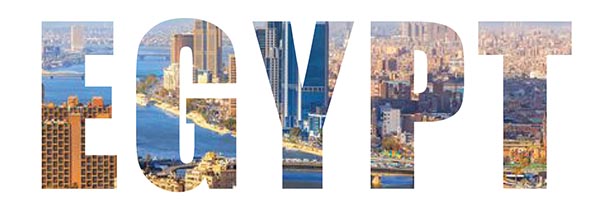
(This article originally ran in the June 4 edition of the drupa daily.)
By Dr. George Nubar Simonian
Egypt with its 110 million population has one of the largest printing and packaging markets in the region and continent.
In addition, Egypt has a long history with printing, dating back to 1798 when Napoléon brought with him three relief printing presses on his ships and started—even before arriving in Egypt, while his troops were sailing in the Mediterranean Sea—to print all the documents needed for his army and for communicating with the Egyptian people.
First Printing House
Napoléon took his presses with him when he left in 1801. About 20 years later, in 1820 (204 years ago), Mohamed Ali Pasha, Governor (Wali) of Egypt, started to build Egypt’s first printing company, Al Amiria Press, which is still working till today, occupying 35,000 sq. m, with nearly 3,000 employees, consuming 20,000 tons of paper, with a capacity of 750,000 B1 sheets printed on both sides on 54 different printing presses per day.
The first newspaper in Egypt and the Middle East, named El Wakae El Masreya, was printed in 1928 headed by its editor Sheikh Mohamed Abdo.
The Federation of Egyptian Industries, first established in 1922, has a special Chamber of Printing & Packaging which was founded in 1969 with 4,415 packaging printers and 2,687 commercial printers as members.
Egyptian Printing & Packaging Industries in Numbers
The Egyptian printing industry is dominated by sheetfed litho offset printing with a market share of approximately 60%, followed by flexo printing with approximately 20% market share. Gravure and screen printing together share about 12% of the market, while digital printing is about 8%.
Egypt has two main uncoated paper mills: Kena with a yearly capacity of 120,000 tons and Edfu with 60,000 tons, representing only about 35% of the total consumption. All the rest is imported.
The total amount of litho offset ink consumed yearly is about 8,000 tons, where sheetfed ink consumption is about 5,000 tons.
The digital printing market size page count comprises:
- 700 million color pages per year.
- 5 billion statements and invoices, and around 1.5 billion black and white pages per year.
In addition, an average of 10 million sq. m of large-format inkjet billboards are printed every year, and in election years this number is estimated to be much more, with some people predicting that it can reach as much as 11 to 13 million sq. m.
Packaging is the fastest growing market in Egypt with a yearly growth of 20%.
Print Education
The first print educational program was introduced 185 years ago when Mohamed Ali Pasha established the Faculty of Applied Arts to serve the Egyptian army at that time, later in 1975 joined Helwan University. Today in its Printing Publishing & Packaging Department, there are more than 330 undergraduate students and more than 42 post-graduate students preparing for their MA, MSc, and PhD degrees.
Also, Egypt is one of the very few countries that has special vocational printing schools, secondary printing schools, higher institutions, and government and private universities, all teaching printing and packaging technologies.
State of the Art Banknote Printing
Egypt is one of the few countries in the region and continent which has its own banknote printing facilities owned by the Central Bank of Egypt, which is considered one of the first printing houses in the Middle East and Africa, established back in 1967 to print the Egyptian banknotes locally.
Recently, the facility has expanded by acquiring the latest printing production machines and fully automated inspection systems in its two branches in Giza and the New Administrative Capital, with the capacity of producing 5,500,000,000 banknotes per year using automatic finishing and Banknote Processing System (BPS) machines, meeting the quantities required by the Central Bank of Egypt and the various Middle Eastern and African central banks on time and in accordance with international quality standards.
Egyptian Printing Day at Drupa
On the second day of drupa, all Egyptian printing industry’s members celebrated together the traditional Egyptian day at drupa, organized by the German Arab Chamber of Commerce in Egypt, the drupa administration, the Egyptian Chamber of Printing and Packaging and Arab Print Media.
This year there are 12 Egyptian companies exhibiting at drupa.
Dr. George Nubar Simonian is Dean of Faculty of Design & Creative Arts, Ahram Canadian University, Egypt.
Die Druckindustrie in Ägypten
Ägypten hat mit seinen 110 Millionen Einwohnern einen der größten Druck- und Verpackungsmärkte in der Region und auf dem Kontinent.
Zudem kann Ägypten auf eine lange Geschichte des Drucks zurückblicken, die bis ins Jahr 1798 zurückreicht, als Napoleon drei Hochdruckpressen auf seinen Schiffen mitbrachte und noch vor seiner Ankunft in Ägypten, während seine Truppen im Mittelmeer segelten, damit begann, alle für seine Armee und für die Kommunikation mit dem ägyptischen Volk benötigten Dokumente zu drucken.
Erste Druckerei
Napoleon nahm seine Druckmaschinen bei seiner Abreise im Jahr 1801 mit. Etwa 20 Jahre später, im Jahr 1820 (vor 204 Jahren), begann Mohamed Ali Pascha, Gouverneur (Wali) von Ägypten, mit dem Bau der ersten Druckerei Ägyptens, der Al Amiria Press, die bis heute in Betrieb ist. Sie umfasst eine Fläche von 35.000 m², beschäftigt fast 3.000 Mitarbeiter, verbraucht 20.000 Tonnen Papier und hat eine Produktionskapazität von 750.000 beidseitig bedruckten B1-Bögen auf 54 verschiedenen Druckmaschinen pro Tag.
Die erste Zeitung Ägyptens und des Nahen Ostens, El Wakae El Masreya, wurde 1928 unter der Leitung ihres Herausgebers Scheich Mohamed Abdo gedruckt.
Der Verband der ägyptischen Industrie, der 1922 gegründet wurde, verfügt über eine spezielle Kammer für Druck und Verpackung, die 1969 gegründet wurde und der 4.415 Verpackungsdrucker und 2.687 Akzidenzdrucker angehören.
Die ägyptische Druck- und Verpackungsindustrie in Zahlen
Die ägyptische Druckindustrie wird mit einem Marktanteil von etwa 60 % vom Bogenoffsetdruck dominiert, gefolgt vom Flexodruck mit etwa 20 % Marktanteil. Tiefdruck und Siebdruck haben zusammen einen Marktanteil von etwa 12 %, während der Digitaldruck etwa 8 % ausmacht.
Ägypten hat zwei große Papierfabriken für ungestrichene Papiere: Kena mit einer Jahreskapazität von 120.000 Tonnen und Edfu mit 60.000 Tonnen, was nur etwa 35 % des Gesamtverbrauchs entspricht. Der gesamte Rest wird importiert.
Die Gesamtmenge der jährlich verbrauchten Offsetdruckfarben liegt bei etwa 8.000 Tonnen, der Verbrauch von Tinten für den Bogendruck bei etwa 5.000 Tonnen.
Der Größe des Digitaldruckmarkts ist in etwa:
- 700 Millionen Farbseiten pro Jahr.
- 1,5 Milliarden Kontoauszüge und Rechnungen und etwa 1,5 Milliarden Schwarzweißseiten pro Jahr.
Darüber hinaus werden jedes Jahr durchschnittlich 10 Millionen Quadratmeter großformatiger Plakate im Inkjet gedruckt, und in den kommenden Jahren dürfte diese Zahl noch steigen, wobei einige Prognosen von 11 bis 13 Millionen Quadratmetern ausgehen.
Der Verpackungsdruck ist der am schnellsten wachsende Markt in Ägypten mit einem jährlichen Wachstum von 20 %.
Drucktechnische Ausbildung
Das erste Ausbildungsprogramm im Bereich Druck startete vor 185 Jahren, als Mohamed Ali Pasha die Fakultät für Angewandte Kunst für die damalige ägyptische Armee gründete, die 1975 in die Helwan-Universität integriert wurde. Heute studieren in der Abteilung Druck, Verlagswesen und Verpackung mehr als 330 Studenten im Grundstudium und mehr als 42 Studenten im Aufbaustudium, die sich auf ihre MA-, MSc- und PhD-Abschlüsse vorbereiten.
Außerdem ist Ägypten eines der wenigen Länder, in denen spezielle Berufs- und weiterführende Schulen, Hochschulen sowie staatliche und private Universitäten Druck- und Verpackungstechnologien unterrichten.
Banknotendruck auf dem neuesten Stand der Technik
Ägypten ist eines der wenigen Länder in der Region und auf dem Kontinent, das über eine eigene Banknotendruckerei verfügt, die sich im Besitz der ägyptischen Zentralbank befindet. Sie gilt als eine der ersten Druckereien im Nahen Osten und in Afrika und wurde 1967 gegründet, um die ägyptischen Banknoten vor Ort zu drucken.
Zuletzt wurden die beiden Niederlassungen in Gizeh und der neuen Verwaltungshauptstadt um modernen Druckproduktionsmaschinen und vollautomatischer Inspektionssysteme erweitert. Die Produktionskapazität liegt bei 5.500.000.000 Banknoten pro Jahr, wobei Maschinen für die automatische Endverarbeitung und das Banknotenbearbeitungssystem (BPS) zum Einsatz kommen, um die von der ägyptischen Zentralbank und den verschiedenen Zentralbanken des Nahen Ostens und Afrikas geforderten Mengen fristgerecht und gemäß internationalen Qualitätsstandards zu produzieren.
Ägyptischer Druckertag auf der drupa
Am zweiten Tag der drupa feierten alle Mitglieder der ägyptischen Druckindustrie gemeinsam den traditionellen ägyptischen Tag auf der drupa, der von der Deutsch-Arabischen Handelskammer in Ägypten, der drupa-Verwaltung, der Ägyptischen Kammer für Druck und Verpackung und Arab Print Media organisiert wurde.
In diesem Jahr sind 12 ägyptische Unternehmen als Aussteller auf der drupa vertreten.
Dr. George Nubar Simonian ist Dekan der Fakultät für Design und kreative Künste der Ahram Canadian University, Ägypten.














